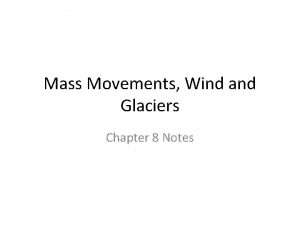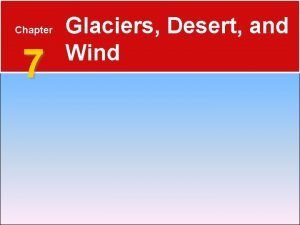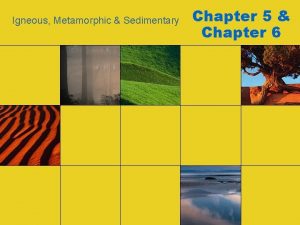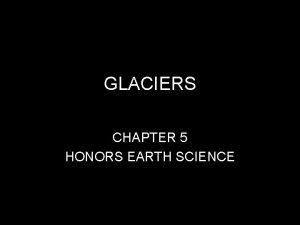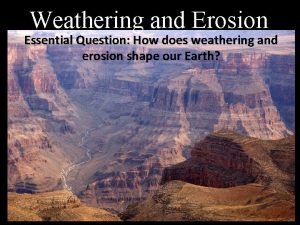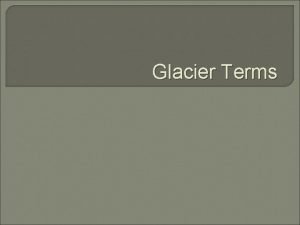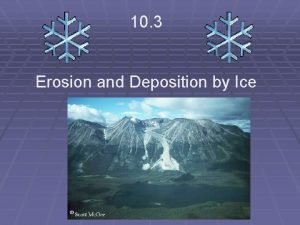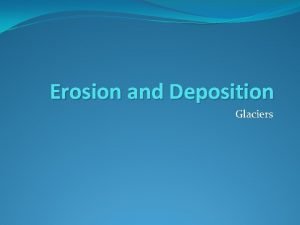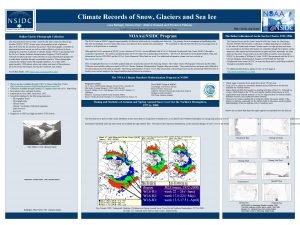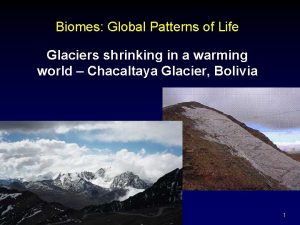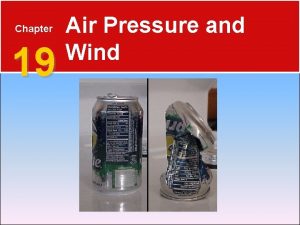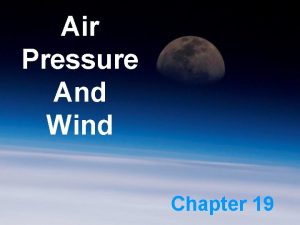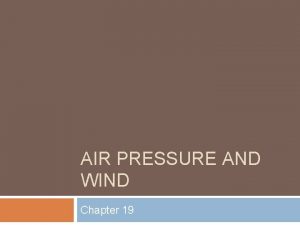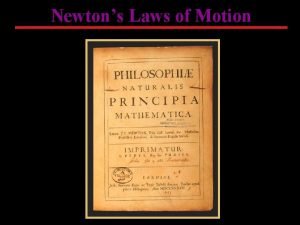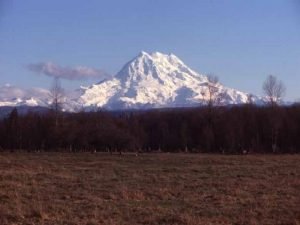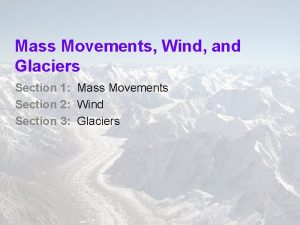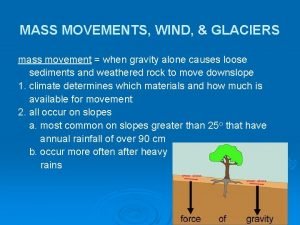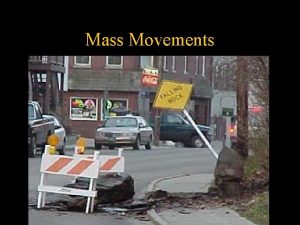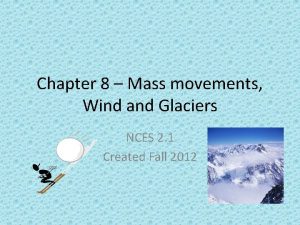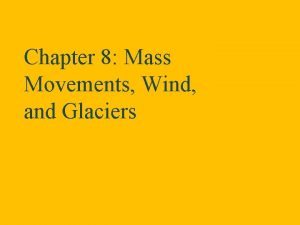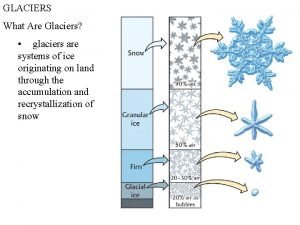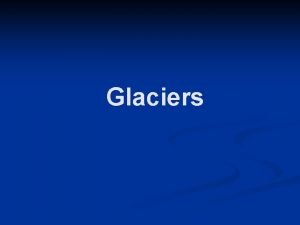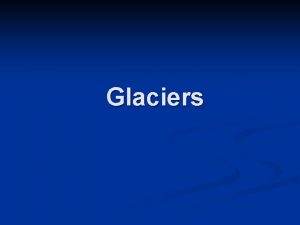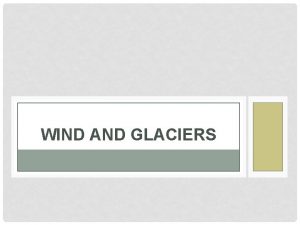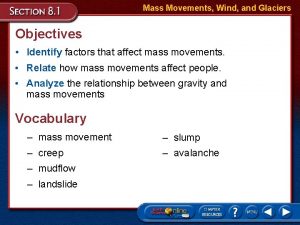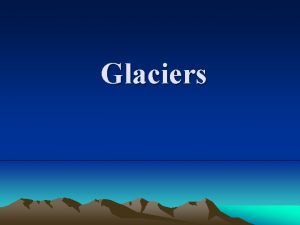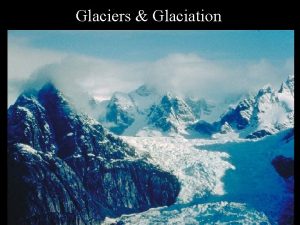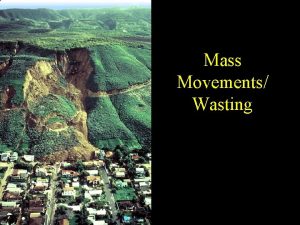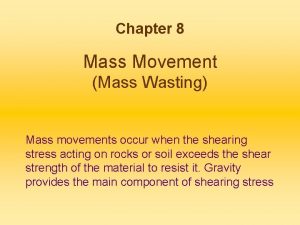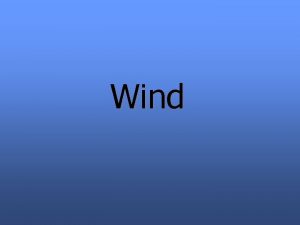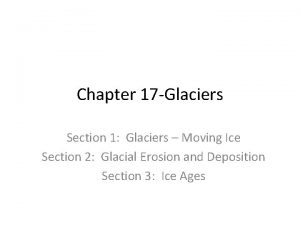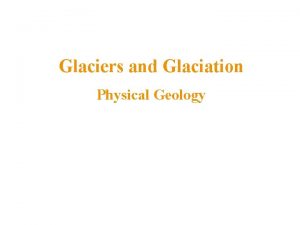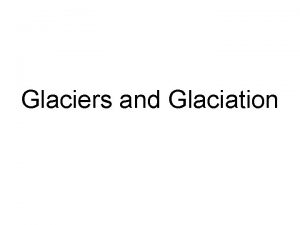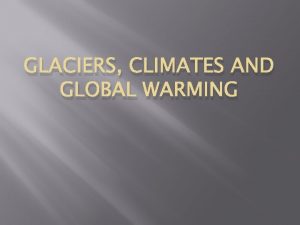Chapter 8 Mass Movements Wind and Glaciers 8



























- Slides: 27

Chapter 8 Mass Movements, Wind, and Glaciers

8. 1 Mass Movements Mass movement is the downward transportation of weathered materials by gravity Most of the Earth’s surfaces are sloped, therefore “mass movements” occur almost everywhere.

Factors that influence mass movement CLIMATE FRICTION COMPOSITION OF THE EARTH MATERIAL TRIGGERS (AN EARTHQUAKE, FOR EXAMPLE, THAT CAN SHAKE MATERIAL LOOSE) WEIGHT OF THE MATERIAL WATER/RAINFALL: INCREASES WEIGHT AND DECREASES FRICTION

Types of Mass Movements • Creep • Flows • Slides • Slumps • Falls

Creep • slow and steady movement of soil down a slope—causes poles, fence posts to lean downhill. Flows • Earthflow—a mass of weathered material that has been saturated with water flows downhill. • Mudflow—the rapid movement of water that contains large amounts of clay and silt.

Slides A rapid, downslope movement of Earth materials that occurs when a relatively thin block of soil, rock, and debris separates from the underlying bedrock is called a landslide.

Types of Landslides Slumps Avalanches • When the mass of material in a landslide moves along a curved surface, a slump results. • Leave distinct crescent-shaped scars on hillsides • Landslides that occur in mountainous areas with thick accumulations of snow. • About 10, 000 avalanches occur in the mountains each year in the western US. • Vibrations from a single skier can trigger an avalanche. • Most common at angles 30 -45 degrees

Review • What is the main underlying force behind all mass movement?

8. 2 WIND

Moving air can transport sediment Wind Erosion • Suspension – when winds causes small particle to be air borne for long distances • Saltation - bouncing motion of sand particles Precipitation limits wind erosion: • Precipitation promotes plant growth that anchors sediment • Moist soil is not carried as easily by wind

Wind Erosion Abrasion: Deflation: • The wearing away of materials through constant pounding of wind-driven sediments. • The lowering of land surface that results from the removal of surface particles. • Ventifacts: rocks that have been shaped by windblown sediments.

Abrasion and Deflation

Wind Deposition • When wind velocity decreases, particles are deposited. • Dunes: piles of windblown sand • Windward side is not as steep as the leeward side • Wind causes dunes to move (“migrate”) • Loess: thick windblown silt deposits. • Loess soils are very fertile due to abundant nutrients and minerals.


Use page 205 to make a table describing the 4 types of dunes Name Barchan Dunes Transverse Dunes Parabolic Dunes Longitudinal Dunes Description

Wind Erosion occurs in areas of little vegetation coverage…

8. 3 Glaciers

Glaciers • Large moving masses of ice • Currently, 10% of Earth’s surface is covered by glaciers • 2 types • Valley glaciers (alpine glaciers) • Continental glaciers

TWO TYPES OF GLACIERS • Valley glaciers—moves within valley walls • Long, slow-moving, wedge-like stream of ice • Also called alpine glaciers • Exist on all continents except Australia

TWO TYPES OF GLACIERS • Continental glaciers—covers a large part of a continent • Occur in areas where all precipitation is snow. • Snow and ice build up and move outward in all directions • Can break off into chunks when it reaches the sea • Greenland glacier—size of Mexico • Antarctica glacier—bigger than U. S. and Mexico combined • A glacier that is less than 50, 000 square meters is called an ice cap.

• Because of their size, weight, and density glaciers are the most powerful erosional agent. • When a valley glacier moves, it breaks off pieces of rock through a process called plucking. Glacial Erosion • As glaciers with rocks embedded in them move over bedrock, they act like sandpaper, grinding parallel scratches into the bedrock. • Small scratches are called striations • Larger ones are called grooves • These marking provide evidence of a glacier’s history and indicate its direction of movements

Glacial erosion, continued • Glacial erosion by valley glaciers creates features known as cirques, horns, and hanging valleys. • Cirques: deep, bowl-shaped depressions caused by valley glaciers • Where there are glaciers on 3 or more sides of the mountaintop, the carving action creates a steep, pyramid-shaped peak called a horn. • Hanging valleys are formed when higher glaciers converge with the lower primary glaciers and later retreat. • When the glaciers melt, the valley is left hanging

Glacial Deposition • Glacial till is the unsorted rock, gravel, sand, and clay that glaciers carry embedded in their ice and on their sides. • Glaciers deposit unsorted ridges of till called moraines when the glacier melts. • Terminal moraines are found along the edge where the retreating glacier melts • Lateral moraines are located parallel to the direction of a valley glacier flow • Outwash plain: the area at the leading edge of the glacier where the meltwater flows and deposits outwash. • Meltwater contains gravel, sand, and fine silt. • When the sediment is deposited by meltwater carried away from the glacier it is called outwash. • Outwash is always sorted by particle size, naturally.

Glacial Deposition, continued Continental glaciers that move over older moraines form the material into elongated landforms called drumlins. The drumlins steeper slope faces the direction from which the glacier came. Stream flowing under melting glaciers leave long, winding ridges of layered sediments called eskers. A kame is a mound of layered sediment that forms when till gets washed into depressions or openings in the melting ice. When the ice finally melts, a cone-shaped hill or mound is left.

Glacial Lakes • Sometimes a large block of ice breaks off a continental glacier and the surrounding area is covered by sediment. When the ice block melts, it leaves behind a depression called a kettle hole. After the ice block melts, the kettle hole fills with water from precipitation and runoff to form a kettle lake.

Glacial Deposition

Chapter Summary: 8. 1 • Mass movements are classified in part by how rapidly they occur • Mass movements are natural processes that can affect human life and activities • Human activities can increase the potential for the occurrence of mas movements 8. 2: • Wind is a powerful erosional agent • Wind can transport sediment in several ways including suspension and saltation • Dunes form when wind velocity slows down and windblown sand is deposited • Dunes migrate as long as wind continues to blow 8. 3: • Glaciers are large moving masses of ice that form near Earth’s poles and in mountain areas. • Glaciers can be classified as valley or continental • Glaciers modify landscape via erosion and deposition
 Examples of mass movement
Examples of mass movement Chapter 7 glaciers deserts and wind
Chapter 7 glaciers deserts and wind Landslides moving water wind and glaciers cause
Landslides moving water wind and glaciers cause Chapter 5 glaciers oceans and landscapes
Chapter 5 glaciers oceans and landscapes Example of locomotor dance
Example of locomotor dance Glaciers cause erosion by abrasion and
Glaciers cause erosion by abrasion and Buffalo ridge minnesota
Buffalo ridge minnesota U shaped valley
U shaped valley Glacial drift vs till
Glacial drift vs till Canatrek
Canatrek Nsidc glaciers
Nsidc glaciers Bolivia glaciers
Bolivia glaciers Raumschotkurs
Raumschotkurs Relative formula mass of hcl
Relative formula mass of hcl Differentiate between atomic number and mass number
Differentiate between atomic number and mass number Atomic mass of oxygen
Atomic mass of oxygen Atomic number mass
Atomic number mass A land breeze usually originates during the
A land breeze usually originates during the Chapter 19 air pressure and wind
Chapter 19 air pressure and wind Air pressure & windwhat is a convection cell?
Air pressure & windwhat is a convection cell? Stoichiometric calculations
Stoichiometric calculations How to calculate percent composition by mass
How to calculate percent composition by mass Inertial mass vs gravitational mass
Inertial mass vs gravitational mass Convert grams to moles
Convert grams to moles Molecules to grams
Molecules to grams Molar mass unit
Molar mass unit Gram mass
Gram mass Units for molar mass
Units for molar mass
